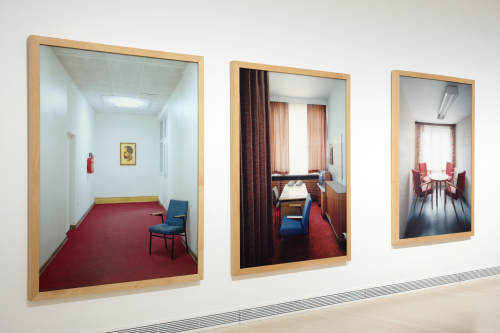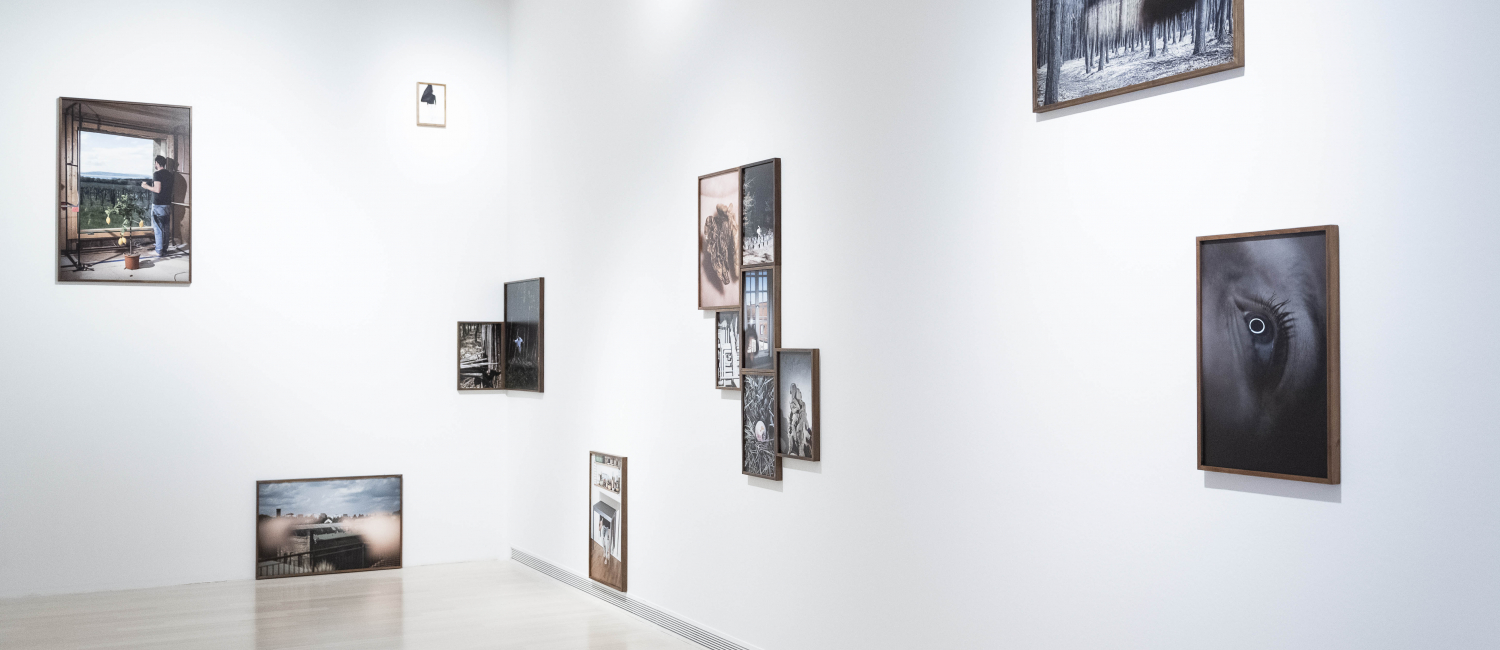The guiding principle of the exhibition is the adaptation of both material and personal sources of trauma by means of the tools of visual art and a novel analysis of their performative representation. We examine how artists’ participation in these processes has changed over the last two to three decades, and what new approaches and perspectives have emerged in different artistic practices. The exhibition is primarily conceived as a platform that, instead of showing works that seek to represent traumatic experiences and tragic events, focuses on creative processes that use art as a potential active tool for processing trauma.
The duality of the exhibition’s English and Hungarian titles reflects the complexity inherent in the topic of trauma. The term emplotment has been transferred from narratology to historiography and it refers to the fact that when a historian arranges events of importance to him or her into a narrative sequence in order to ‘narrate’ a particular historical period, this selection and arrangement is determined more by the narrative rules of storytelling than by historiography’s endeavour for objectivity. Discrete events must be ‘emplotted’ in order to take narrative form. In the context of the exhibition, the two terms (előhívás and emplotment) complement each other as they refer to two interdependant aspects of trauma processing.
The study of the relationship between art and trauma has a long history, which has only grown stronger with the spread of trauma research. In the last two decades, however, a number of new methods and aspects have come to the fore. The various branches of trauma studies as well as artistic trauma research (in Hungary, mainly related to the Holocaust) are accompanied by extensive literature and a myriad of approaches. For the above reasons, we have consciously tried to avoid a thematic approach to the sources of trauma, the analysis of their psychological or art-therapeutic narrative, or the exploration of their historical context, and consequently, we do not return to the Holocaust. As our focus is explicitly on the recent past, the exhibition emphasises the gravity and role of positions outlined through artistic practices.
The exhibition makes the notion of trauma permeable in its layered interpretations and intensities, to make room for often less visible but deeply rooted issues. Accordingly, some less obvious sources of trauma are also included in the exhibition, emphasising the everyday aspects of trauma.
We should also mention the introduction of the “empathic vision”: the idea – based mainly on the avant-garde artistic model – that previously used to dominate discourse, which focused on trauma and its representation, has recently been pushed into the background. The proposition was brought to the fore in this form in a 2005 volume by art theorist Jill Bennett, a landmark in this field that articulated the “empathic vision”. It highlighted an idea that was already very much in evidence at the time, and has since become clearly established, namely the role of the “relational aspect”, which is exactly what the exhibition is focused on. Referring to Jill Bennett, the relational aspect has superseded the representational and has created a new commitment towards the processing of trauma at the individual and social level. This kind of “empathic vision” allows art not to interpret or repeat the traumatic event, but to provide empathic testimony, manoeuvring a combination of emotional and intellectual threads at the same time.
The exhibition presents five artistic positions – without seeking to cover all possible artistic stances and give rise to another closed discourse. We have highlighted the relevant common denominators and intersections from the perspective of our own curatorial approach, adapting them to the positions that emerge through artistic expressions: revealing, catalyst, resource, reparative, performative. Further nuanced in the specific works, these positions also support the exhibition’s aim to provide a possible interpretative framework through which we can delve deeper into understanding the processes that are currently affecting society and the positions that drive the artists.
With regard to the Central and Eastern European region and the Hungarian context, these studies can not only shed new light on the recent past, but also leave room for interpreting quite distant, seemingly closed discourses, for unravelling historically superimposed, conflated and suppressed perspectives. Within the visual arts scene, the micro-historical perspective, and occasionally the artist’s personal involvement, experience or direct engagement with certain sources of trauma, has triggered new narratives and diverse ways of processing them. The emergence of the latter has contributed to the rewriting of authorized narratives, and digital technology has allowed previously unexplored connections and correlations to emerge in a very short time, upending previously conventional research methods and generating a ‘short-circuit’ within the academic hierarchy.
Instead of aiming to create a closed framework, the exhibition intends to use its platform character to allow the narrative emplotment to evolve, to involve the viewer in the process and to provide insight into the propositions – which is facilitated by the associated microsite that will constantly expand and develop in the course of Emplotment.
Exhibiting Artists
ALBERT Ádám, Kader ATTIA, Mohamed BOUROUISSA, CHILF Mária, Phil COLLINS, Susana Pilar DELAHANTE MATIENZO, Andrii DOSTLIEV & Lia DOSTLIEVA, Harun FAROCKI, Daniel & Geo FUCHS, HAVEIT Collective, HTEIN LIN, Alfredo JAAR, Belinda KAZEEM-KAMIŃSKI, KESERUE Zsolt, NEOGRÁDY-KISS Barnabás, Janette PARRIS, Ruti SELA & Maayan AMIR, Selma SELMAN, Taryn SIMON, SOSTAR? csoport | group [2013–2014]
Curators: FEIGL Fruzsina, KÁLMÁN Borbála, TIMÁR Katalin
Exhibition Concept: FEIGL Fruzsina, KÁLMÁN Borbála
Download the exhibition booklet HERE.
The exhibition is realized as part of the Petőfi 200 Memorial Year.


Related contents

Emplotment. The microsite
The microsite for the exhibition features additional information about the artists and the concept of the exhibition.

Virtual tour in the Emplotment exhibition
The guiding principle of the exhibition is the adaptation of both material and personal sources of trauma by means of the tools of visual art and a novel analysis of their performative representation.

CANCELED | Guided tour in English in the Emplotment exhibition 28. August, 2022, 17:00–18:00
This international group exhibition focuses on the adaptation of sources of trauma by means of visual art and a novel analysis of their performative representation.

CANCELED | Guided tour in Hungarian in the Emplotment exhibition 28. August, 2022, 16:00–17:00
This international group exhibition focuses on the adaptation of sources of trauma by means of visual art and a novel analysis of their performative representation.

Ludwig Lounge: Emplotment 27. August, 2022, 16:00–19:30
This LudwIg Lounge is the finissage event of the Emplotment exhibition.

Guided tour in English in the Emplotment exhibition 14. August, 2022, 17:00–18:00
This international group exhibition focuses on the adaptation of sources of trauma by means of visual art and a novel analysis of their performative representation.

Guided tour in Hungarian in the Emplotment exhibition 14. August, 2022, 16:00–17:00
This international group exhibition focuses on the adaptation of sources of trauma by means of visual art and a novel analysis of their performative representation.

Guided tour in English in the Emplotment exhibition 31. July, 2022, 17:00–18:00
This international group exhibition focuses on the adaptation of sources of trauma by means of visual art and a novel analysis of their performative representation. The curators examine how artists’ participation in these processes has changed over the period of the last twenty to thirty years, and what new approaches and perspectives have emerged and come to the fore.

Guided tour in Hungarian in the Emplotment exhibition 31. July, 2022, 16:00–17:00
This international group exhibition focuses on the adaptation of sources of trauma by means of visual art and a novel analysis of their performative representation.

Guided tour in English in the Emplotment exhibition 17. July, 2022, 17:00–18:00
This international group exhibition focuses on the adaptation of sources of trauma by means of visual art and a novel analysis of their performative representation.

Guided tour in Hungarian in the Emplotment exhibition 17. July, 2022, 16:00–17:00
This international group exhibition focuses on the adaptation of sources of trauma by means of visual art and a novel analysis of their performative representation.

Guided tour in Hungarian in the Emplotment exhibition 3. July, 2022, 16:00–17:00
This international group exhibition focuses on the adaptation of sources of trauma by means of visual art and a novel analysis of their performative representation.

Exhibition Opening: Emplotment 12. May, 2022, 18:00–19:30
The Ludwig Museum – Museum of Contemporary Art cordially invites you to the opening of the exhibition EMPLOTMENT on Thursday, 12 May 2022 at 6 p.m.




